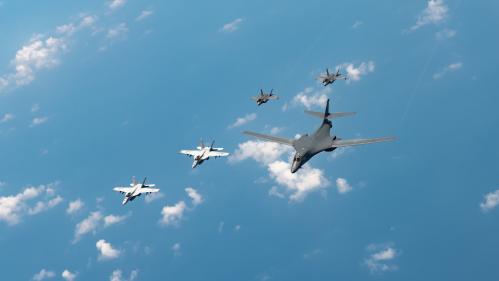With the recent release of the proposed fiscal 2023 Department of Defense (DOD) budget and the coming rollout of the National Defense Strategy (NDS), defense analysts are deeply engaged in evaluating the Biden administration’s plans. Both items are behind traditional release schedules and more detailed information is still to be released. Congress got a classified NDS, but currently only a two-page summary is available to the general public. The defense policy community has delved into the limited available material in articles, papers, panels, and podcasts and the reaction has been uniformly deep concern. Although it is the United States’ largest proposed DOD budget to date at $773 billion, many argue it does not go far enough to meet the needs outlined in the NDS summary; particularly in respect to current and expected inflation, the impact of the ongoing Russian invasion of Ukraine, and adequate capability across a number of established or planned military programs.
INFLATION
Global inflation poses significant challenges for the defense budget. DOD spending undergirds the most visible instrument of U.S. national security, so the risk associated with miscalculation can be grave. Many experts see the budget’s calculation of expected inflation to be completely insufficient, with a Consumer Price Index (CPI) rate of 8.5% through March and little hope of quick fix before the 2023 budget year. DOD Comptroller Michael McCord noted that defense budgets are not constructed using the CPI as a benchmark, but this budget was planned with a 4% inflation rate.
If inflation remains well above the planning figure, U.S. military operations will be hampered, and prospects will worsen if a budget does not get passed in time and the military must operate on continuing resolutions. Continuing resolutions are particularly damaging for new programs as they tend to cause delays and increase costs.
High inflation is likely to turn a 4% increase over the enacted 2022 budget into a net reduction in real expenditures after many years of delaying significant investment in programs critical to national defense and strategy. Each of the services is recapitalizing after decades of fighting the global war on terror and are preparing for increased competition with China, a decidedly different conflict. Lacking the additional details expected mid-April, defense budget analysts remain extremely pessimistic that the budget as proposed is suited to withstand current inflationary trends.
RUSSIA, UKRAINE, AND NATO
Both the budget and the NDS were in a lengthy cycle of development before they were released, and there is concern Russia’s invasion of Ukraine, launched on February 24, isn’t adequately addressed in those documents. Since both documents are written at the strategic level, and Russia has already proven willing to invade neighboring former Soviet states, one could argue that this most recent conflict is not an aberration, even if it highlights a shortcoming in U.S. deterrence. The current war is far beyond the scale of previous Russian actions, however, and U.S. and NATO collective action has been considerably greater as well, so the room for underestimating how this conflict unfolds grows.
Even if the war doesn’t go on into the next budgetary year, continued global economic disruption (notably in energy, and disproportionately effecting NATO allies such as Germany) and additional aid for Ukraine is expected; the U.S. and its allies will likely feel the effects of operating in a resource-constrained environment. President Joe Biden has now announced the authorization of another $800 million in military aid to Ukraine on top of $2.4 billion already given. The U.S. has already approved some troop plus ups in Europe, but there already are calls for additional U.S. troops in eastern Europe, including from the chairman of the Joint Chiefs of Staff, Gen. Mark Milley, who believes rotational forces might be needed for years to come. Finland, which shares an 830-mile border with Russia, and Sweden are now considering joining NATO despite Russian warnings. Given these circumstances, the proposed budget may not have coming increased costs calculated in.
CAPABILITIES
As mentioned earlier, each of the services are investing in programs that are overdue for upgrade, notably all three segments of the nuclear triad at the same time ($34.4 billion), but also continued efforts into next generation capabilities in artificial intelligence, cyber, and hypersonic missiles. The DOD budget allocates a new high of roughly $130 billion for research, development, test, and evaluation, and investing in potential future capability has its place, but if the budget doesn’t allocate sufficient money to proven and deliverable capability now and in the near future, the U.S. will incur greater risk. The services propose to draw down expensive-to-operate older systems at a quick rate to free money for newer systems, which is logical, but the net effect is to decrease the size of the surface naval fleet, the air fleet, and even cut Army end strength. This aspect of the budget is widely seen as the most contentious by military analysts. Reducing so many parts of the force at one time will need to be clearly explained and articulated to gain the support of Congress. Many experts anticipate that Congress will add additional funds to the budget as it did last year to address concerns of a smaller, arguably less capable force.
A critical concern made by analysts is that over time, the DOD has fielded modern weapon systems at higher cost and in lower numbers; even if this smaller inventory of equipment is up to the task of constant deployment and use (all equipment must be taken out of use for maintenance or repair, especially if a system is programmed for an upgrade), the force at its current size may be too small to meet the requirements of the NDS. One of the starkest assessments of this situation comes from retired Air Force General David Deptula, who routinely describes the current aircraft inventory as the “oldest, smallest, and least ready in its history.”
Reductions make sense due to several factors — high operational cost, diminishing relevance in a contested environment, or the need for modernization — but the reduction in F-35s in this budget may be worthy of another look. The F-35 is a modern multi-role fighter aircraft, but operating costs are considerably higher than had been expected, and the Air Force prefers to wait for Block 4 versions able to fully leverage hardware and software improvements that won’t need costly upgrades later. However, maintaining the Air Force’s planned purchase of 48 instead of 33 as specified in the new budget would increase the number of fifth generation aircraft in the inventory in the near term. We do not know for sure when these aircraft will be needed, but delaying nearly a squadron’s worth of aircraft when the inventory is already smaller than ever is a risk. The production line for F-35s has capacity that the U.S. should secure; Germany just committed to buying F-35s as part of a large investment in defense in response to Russia’s aggression and other countries may do the same. The Air Force opted for fewer F-35s to increase money available to buy more F-15EX air superiority aircraft (meant to fight other aircraft, optimally at long range), which provide a capability that allows other aircraft and other warfighting domains to perform their functions, so that decision makes fiscal sense. If Congress opts to plus up the budget to deliver capability, increased numbers of F-35s is a logical path to consider; the Air Force indicated they would buy more F-35s if they had the resources and included them on their supplemental “wish list.”
The Navy faces a similar issue with an overall reduction in the number of ships. A smaller U.S. Navy is hard to fathom when China has expanded or improved so many of its military capabilities and can project power beyond its shore like never before. The Navy is central to the U.S. response to the scenario of a Chinese attempt to take Taiwan, and a smaller fleet may be perceived as less of a deterrent by Beijing. Whether a perception of a weaker Navy is correct or not may not even matter; if this budget leads China to believe that the United States is less capable of defending Taiwan, it may choose to test the matter.
MEETING THE MOMENT
As the budget continues through the cycle to approval, there is certain to be spirited debate on how it can meet the objectives outlined in the new NDS. Congress will be very interested in the challenges posed by inflationary forces, how the impact of the Russian invasion of Ukraine may be felt even if hostilities cease, and whether changes in military programs may pose unacceptable risk if the arsenal is decreased amidst modernization without adequate mitigation.
Before Russia launched its assault on Ukraine, many thought that one of the world’s largest militaries, given years of investment, would roll through the country and meet its objectives quickly. But as the conflict thus far has shown, Russia’s capabilities were grossly overestimated. It is certain that Congress will want to ensure that the U.S. military is built to be ready when it is needed.
The views expressed herein are solely those of the author and do not necessarily represent the views of the U.S. Government or the Brookings Institution.
The Brookings Institution is committed to quality, independence, and impact.
We are supported by a diverse array of funders. In line with our values and policies, each Brookings publication represents the sole views of its author(s).









Commentary
As Biden administration’s defense budget and National Defense Strategy emerge, concerns abound
April 13, 2022